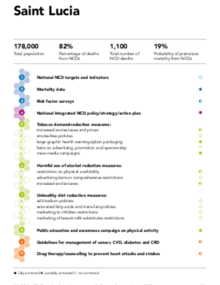Saint Lucia is an island nation in the Caribbean, located between Martinique and Saint Vincent and the Grenadines. With a land area of 620 km2, it is divided into 11 districts. It is a parliamentary democracy and holds elections every 5 years.
In 2000 the total population of Saint Lucia was 159 500 inhabitants; by 2023 this figure had risen to 180 251, representing a 13.0% increase. Regarding the country’s demographic profile, in 2023 people over 65 years of age accounted for 9.5% of the total population, an increase of 2.3 percentage points compared to the year 2000. In 2023, there were 102.4 women per 100 men and 53.5 older people (65 years or older) per 100 children under 15 years of age, as can be seen in the country’s population pyramids, distributed by age group and sex (Figure 1). Considering the population between 15 and 64 years of age to be potentially active (i.e., potential participants in the labor force), this group represented 72.8% of the total population of the country in 2023 (131 150 people). When we add these figures to the potentially passive population (31 988 under 15 years of age and 17 114 over 65 years of age), the result is a dependency ratio of 37.4 potentially passive people per 100 potentially active people. This ratio was 63.8 in 2000.
Life expectancy at birth in 2023 was 74.1 years, lower than the average for the Region of the Americas and 3.3 years higher that in 2000.













